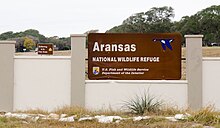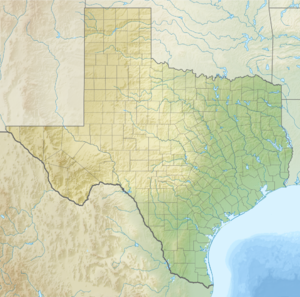| Aransas National Wildlife Refuge | |
|---|---|
IUCN category IV (habitat/species management area) | |
 Wetlands at Aransas National Wildlife Refuge looking out from the 40 ft observation tower. | |
| Location | Aransas, Calhoun, Refugio counties, Texas, United States |
| Nearest city | Austwell, Texas |
| Coordinates | 28°16′00″N 96°49′00″W / 28.26667°N 96.81667°W |
| Area | 115,324 acres (466.70 km2) |
| Established | 1937 |
| Governing body | U.S. Fish and Wildlife Service |
| Website | Aransas National Wildlife Refuge |

Aransas National Wildlife Refuge is a 115,324-acre (466.7 km2)[1] protected area situated on the southwest side of San Antonio Bay along the Gulf Coast of the U.S. state of Texas. It is located in parts of Aransas, Refugio, and Calhoun Counties. It is situated on the southwest side of the San Antonio Bay, formed by the mouth of the Guadalupe River. It also includes nearly the entirety of Matagorda Island, a 38-mile barrier island.[2] The Aransas National Wildlife Refuge was established by Executive Order 7784 on 31 December 1937 by President Franklin D. Roosevelt as the Aransas Migratory Waterfowl Refuge as a refuge and breeding ground for migratory birds and other wildlife. Roosevelt issued a proclamation in 1940 changing the name to the Aransas National Wildlife Refuge.[3]
In October 1938, Civilian Conservation Corps Company 880 established camp south of Austwell, Texas. They built roads, ditches, firebreaks, and the residence facilities for the refuge. They constructed part of the spillway for Burgentine Lake, which serves as a major resting area for migratory waterfowl. They also graded the road to Austwell.[4]
Bird life includes ducks, herons, egrets, ibises, roseate spoonbills, and the endangered whooping crane, whose population has recovered significantly since the 1940s.
Other fauna include American alligators, collared peccaries, snakes, and bobcats, which inhabit the refuge's grasslands, blackjack oak thickets, freshwater ponds, and marshes.
- ^ USFWS Lands Report, 30 September 2019
- ^ National Wildlife Refuge System. "Matagorda Island Unit". U.S. Fish & Wildlife Service. US Department of the Interior. Retrieved 1 January 2020.
- ^ "Proclamation 2416". Wikisource. Retrieved 28 March 2018.
- ^ Aransas National Wildlife Refuge, accessed February 12, 2018.

